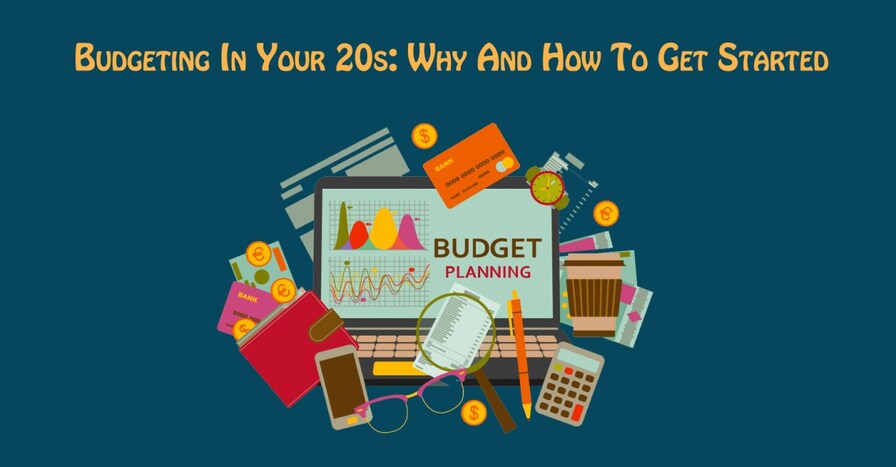Budgeting In Your 20s: Why and How To Get Started

The foundation of your future financial independence lies in your present spending and saving habits. The 20s is the time when people generally start to earn their first salaries. It is the time when they start thinking about major financial decisions like buying a house or a car or paying off their student debts. Therefore, the 20s is the time to establish good financial habits, such as budgeting, credit building, and saving money.
This article aims to understand why one should start budgeting and how and where one should invest for maximum gains.
Why Should You Develop A Habit Of Budgeting?
Saving money early allows you to get more out of each rupee held.
If you don’t have a consistent saving habit, it doesn’t matter how much money you make. However, if you start saving early, you will have more money later. Compound interest is the reason for this.
When you invest your money early, you receive interest on the original investment and earn interest on your interest over time. However, the longer you wait for your investment to grow, the more money you get from each rupee.
Budgeting helps you plan for significant expenses in the future.
If you want to buy a car or a house, you will have to spend a significant amount of money.
However, when you start saving earlier, you’ll have a smaller financial burden when the time comes. It’s also crucial to understand how to stick to a budget so that you can cope when things get complex with your finances.
Why to Set Up a Budget in your 20’s?
Save for the lifestyle you want
When you’re young and free of significant commitments, it is the perfect time to do the things you want to do. You’d be shocked how much money a spending plan can save you.
Tracking your expenditure can help you uncover areas for improvement, allowing you to spend less on items you don’t need and more on more important things.
Become debt-free sooner
Get rid of your debt worry once and for all. Budgets make it easier to pay off debt without putting your wages under strain. In addition, making it a habit to save a little every month will help you cross items off your list much faster.
There is less stress when coping with unanticipated expenses.
Life is unpredictable. And it means last-minute dentist appointments, automobile difficulties, a roof leak, and so on. However, budgets ensure that you always have enough cash on hand in unforeseen circumstances.
It would help if you didn’t have to borrow money from friends and family or waste money on high-interest loans.
How should you set up a budget in your 20’s?
Here’s a step-by-step approach to creating a budget in your twenties and gaining financial control early on.
Step 1: Determine how much money you earn after taxes
You might be getting paid weekly, biweekly, or once a month. First, determine your total monthly take-home pay after taxes and other deductions in either case. The amount left is the amount you’ll use to set your spending limits.
Step 2: Make a plan
Getting your finances in order is a terrific goal, but it’s also necessary to aim toward something specific. It encourages us to be meticulous and regular in our budgeting.
What if I don’t have a specific aim in mind?
Create one. Creating an emergency reserve for unanticipated expenses is an excellent first objective.
Other possible objectives include:
- Short-term goals include saving for a vacation.
- Medium-term objectives: Saving for a car and becoming debt-free.
- Long-term objectives: putting money down for retirement or paying off your home loan.
Step 3: Make a list of all of your recurring expenses
Certain monthly expenses are unavoidable, such as rent, auto payments, and cell phone bills. Evaluate your bank and credit card statements to see how much they cost on average.
For example, your rent payment may be consistent month after month, but your groceries costs may vary. Examine your bank statements and credit card invoices from the previous three months. If you spent 4000, 4500, or 5000 on groceries over three months, use 4500 as your monthly food allowance because it is an average of what you may spend.
Step 4: Make a list of your one-time expenses
There are payments that you pay regularly, and then there are ones that only appear once every six months or once a year. Some people, for example, pay their auto insurance company annually to save money by paying the premium in one flat sum. Examine your bank and credit card bills from the previous year to ensure that you’ve accounted for all of those one-time expenses, and then factor them into your budget.
Let’s say you regularly spend 1,200 on auto insurance each year, but you only pay it in June. In that situation, you’d budget for 100 in auto insurance each month.
Step 5: Make savings your habit
Every month, you should try to save a certain amount of money. That sum may be tiny when you’re in your 20s and just starting in the workforce, but it may grow over time. So make saving an official line item in your budget, no matter how modest, to keep it on your radar. Today there are several digital banks in the market that encourages banking for teens and also help you to learn and get financially independent over time. You can try one of them for saving up and they have different plans to incentivize you when you do good in money management.
Step 6: Improve your credit score
A strong credit score is essential for availing of other financial products, such as credit cards and loans. Furthermore, the higher your credit score, the better conditions you’ll be offered, potentially saving you thousands of rupees in interest over time.
One of the drawbacks of developing credit is that you must have some credit history to qualify for a credit card. However, once you have a credit card, the simplest method to raise your credit score is to use it frequently, be mindful to spend within your means, make sure you pay the minimum amount due at least on time each month, and pay off your balance in full every month.
Step 7: Put money aside for emergencies
Establishing an emergency fund to cover unforeseen expenses, such as medical bills or auto repairs, is one of the most brilliant things you can do in your twenties. In addition, your emergency fund can help you avoid taking out a loan or carrying a credit card balance, potentially saving you money on interest rates.
Consider saving in Neobanks; they have lower operational costs than traditional banks, and they can provide better rates on some deposits, savings, and loan products.
Step 8: Get rid of your debt
If you have a student loan or credit card debt, paying it off should be a top focus in your twenties. Having money owed to a lender can harm your credit by increasing your utilization rate (the percentage of credit you use), leading to a lower credit score. If you have a large amount of debt, lenders may consider you a high-risk borrower, limiting your ability to qualify for other financial products. You’ll end up paying a lot of money in interest charges the longer you hold debt, in addition to harming your credit score.
If you have multiple credit card bills, you may want to consider debt consolidation.
Where to Invest Your Money?
It’s just as vital to keep your money in a safe place as it is to invest it. The following are some of the suitable plans for people with various risk profiles and income levels.
-
Savings plans at the post office
The post office is a haven for your cash. They provide competitive interest and absolute capital protection through various schemes such as 5-year RD, POMIS, National Savings Scheme, and others.
-
Public Provident Fund
PPF is a long-term retirement savings plan created by the government that now pays 7.6% interest. To get the most benefit, one can start investing at the beginning of the fiscal year. Interest, capital, and earnings are all tax-free.
-
Liquid Funds
Liquid funds focus on ultra-short-term assets such as bonds, government securities, and treasury bills, and they earn you money while protecting your wealth. The fund manager invests in debt instruments with a maximum maturity of three months (91 days). It is an excellent emergency fund investing option because it is very liquid and low-risk.
-
Recurring Deposits
Establishing a short-term savings plan is always a good idea, like an emergency fund. Maintaining a six-month to one-year RD, for example, can guarantee that you always have cash on hand. It’s simple to get started with internet banking. The majority of banks have interest rates ranging from 6% to 7%. Consider saving in Neobanks as it customizes offering according to the needs of its customers.
-
Systematic Investment Plans (SIPs)
The superior return-generating potential of equity funds makes them popular. However, many people believe that investing in equity funds requires a large sum. It is not so. One may easily set aside a small amount of money by investing through SIPs (as per your comfort and convenience). SIP plans are offered weekly, monthly, fortnightly, quarterly, and even daily.
Also Read: Post Office FD – Know Latest Rates & Returns 2021
-
Debt Funds
Debt funds are yet another low-risk investment that guarantees capital preservation. When a financial institution or a firm borrows money from you (together with hundreds of other investors) and pays you interest, it is called a debt fund. Regardless of the company’s performance, you will receive consistent money. Ideal for those looking for a steady source of income.
-
Life Insurance
When you’re in your twenties, getting life insurance means you can get more coverage for a lower price. As you age, your insurance costs will rise as well. If you do not have health insurance, one medical emergency can wipe away all of your savings. Life insurance purchased at a younger age, on the other hand, can provide a wealth of benefits at a lower cost.

Pranab Bhandari is an Editor of the Financial Blog “Financebuzz”. Apart from writing informative financial articles for his blog, he is a regular contributor to many national and international publications namely Tweak Your Biz, Growth Rocks ETC.





